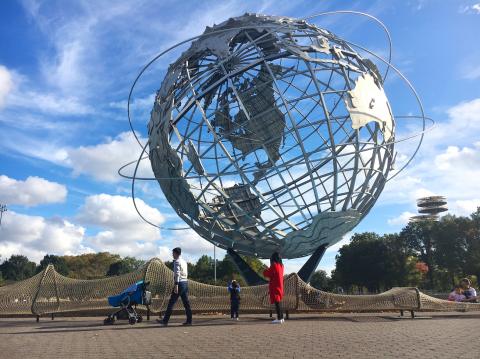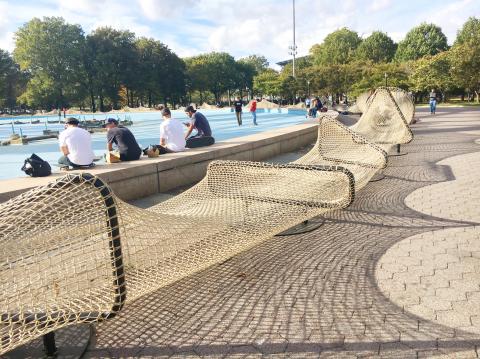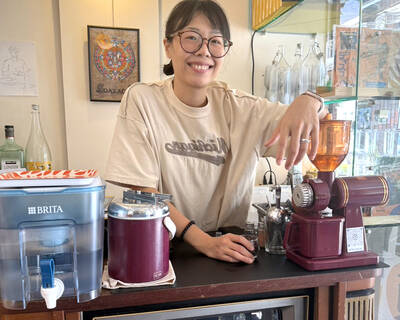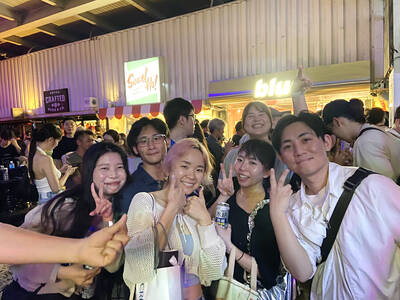Kids jumped on it as they would a trampoline. Adults laid on it, some wearing earphones, some reading a book — even one smoking a cigar. Most weren’t sure what it was.
As debate rages on over border security and building a wall between Mexico and the US, a fence of its own went up this month in one of the most ethnically diverse corners on earth, the New York City borough of Queens.
The Unisphere in Flushing Meadows-Corona Park is among the spaces in New York chosen for Ai Weiwei: Good Fences Make Good Neighbors, an outdoor exhibition prepared by the human rights activist and prominent Chinese contemporary artist Ai Weiwei (艾未未).

Photo: Chris Fuchs
Ai brings his work to the Big Apple, long a berth for immigrants, after traveling to more than 40 refugee camps in 23 countries while filming his documentary Human Flow, an exploration into the global refugee crisis.
That one of his fences encircles the iconic globe of the 1964-1965 New York World’s Fair — a structure built to symbolize a spirit of world unity — holds significance for some who visited it one unseasonably warm Saturday late last month.
“Especially being around the Unisphere and the whole world being in the background of this, I think that’s really nice,” said Erin Little, 29, of Manhattan. “Bringing it into Queens, you can find anything and everyone here.”

Photo: Chris Fuchs
Ai Weiwei: Good Fences Make Good Neighbors is presented by the Public Art Fund, a nonprofit, and opened on Oct. 12. The title takes its name from an old adage quoted in the Robert Frost poem Mending Wall, in which two neighbors discuss whether a stone partition is necessary for separating their property.
The exhibition features fence installations at, among other locations, Manhattan’s Washington Square Arch and the Doris C Freedman Plaza at Central Park, in addition to the one in Queens. In all, it includes related works at bus shelters, on lampposts and at private buildings at more than 300 locations across the city’s five boroughs.
“Collectively, these elements comprise a passionate response to the global migration crisis and a reflection on the profound social and political impulse to divide people from each other,” writes the Public Art Fund.
LAID-BACK WORK
While the Manhattan sites have received a lot of attention — including protests from some over the Washington Square Arch structure — the Flushing Meadows-Corona Park one has flown largely under the radar, park-goers here said.
At first blush, the undulating netted fence, constructed with rope and interconnected with metal frames of various shapes, resembles a hammock.
And, of course, a natural response to seeing a hammock is to lay down on it.
That’s exactly what Liu Pin, 36, was doing while his wife, Zhang Bin, watched over their four small children who jumped and climbed all over Ai’s installation.
“It’s comfortable,” said 30-year-old Zhang, speaking in Mandarin.
The couple, immigrants from Fujian Province, China, knew about Ai, a frequent critic of Beijing whom the Chinese government once arrested, detained and stripped of his passport, returning it only in 2015.
But neither had heard anything about the exhibit, they said.
“This is the first day we saw this,” Zhang said.
Liu added that he initially assumed it was something provided as a government benefit for leisure.
Zhang and Liu, of Queens, were not alone in their confusion. Colin McGivern, who was with his wife, Gin Cheng, and their two children, were also stumped when asked about the installation.
“I thought it was a barrier,” Cheng, 35, said.
“I thought it was a tunnel for kids to crawl through,” McGivern, 40, added.
McGivern, it turns out, was partially correct. A few kids discovered an open slit in one segment of the exhibit and clambered around inside. (It wasn’t immediately clear if the opening was created by the artist or by visitors.)
Little, the 29-year-old from Manhattan, said she had heard about Ai’s installation at Washington Square Park, but not the one at Flushing Meadows-Corona Park, aptly entitled Circle Fence.
She stumbled upon it after walking over from volunteering at the zoo.
“I thought it was really cool,” Little said. “I thought it was unique that everybody was kind of all together. And it looked like a great place to read for a little bit and enjoy the beautiful day.”
Like Little, most park-goers came to bask in the brilliant sunshine of a balmy October afternoon, delighting in weather that has tricked many New Yorkers into believing it’s Spring instead of Fall.
As the Mister Softee ice cream truck jingle played in the background, kids treated Circle Fence like their own personal jungle gym. Most adults took a more reserved approach, lounging on it to rest, close their eyes, read a book or take selfies. Teenagers fell somewhere in between.
SMALL WORLD AFTER ALL
It was a classic New York moment in a borough that boasts the city’s largest percentage of people born outside the US and that, according to New York State, is considered “the most ethnically diverse urban area in the world.”
And that’s when for some, the significance of Ai’s work began to set in.
Little made an observation, one she didn’t realize until she had laid down — the fence moves every time people hop on or adjust themselves.
That, she believed, had meaning.
“We’re all connected, so even if you’re building up these fences between all these people, we’re still all together and all connected,” Little said.
Zhang and Liu, the couple from China, thought out loud about Ai’s installation — and the meaning of fences and community — as a reporter explained the background of the exhibition to them.
“If we’re laying over here and someone suddenly sits down over there, we’ll feel it over here,” Zhang said.
“If we lay down here, we’ll disturb people over there,” Liu added.
“Wow,” he said. “This has many deep layers of meaning to it, right? Such a strong artistic sense... Subtle yet profound.”
“Ai Weiwei: Good Fences Make Good Neighbors” runs until Feb. 11 next year.

Cheng Ching-hsiang (鄭青祥) turned a small triangle of concrete jammed between two old shops into a cool little bar called 9dimension. In front of the shop, a steampunk-like structure was welded by himself to serve as a booth where he prepares cocktails. “Yancheng used to be just old people,” he says, “but now young people are coming and creating the New Yancheng.” Around the corner, Yu Hsiu-jao (饒毓琇), opened Tiny Cafe. True to its name, it is the size of a cupboard and serves cold-brewed coffee. “Small shops are so special and have personality,” she says, “people come to Yancheng to find such treasures.” She

Late last month Philippines Foreign Affairs Secretary Theresa Lazaro told the Philippine Senate that the nation has sufficient funds to evacuate the nearly 170,000 Filipino residents in Taiwan, 84 percent of whom are migrant workers, in the event of war. Agencies have been exploring evacuation scenarios since early this year, she said. She also observed that since the Philippines has only limited ships, the government is consulting security agencies for alternatives. Filipinos are a distant third in overall migrant worker population. Indonesia has over 248,000 workers, followed by roughly 240,000 Vietnamese. It should be noted that there are another 170,000

Hannah Liao (廖宸萱) recalls the harassment she experienced on dating apps, an experience that left her frightened and disgusted. “I’ve tried some voice-based dating apps,” the 30-year-old says. “Right away, some guys would say things like, ‘Wanna talk dirty?’ or ‘Wanna suck my d**k?’” she says. Liao’s story is not unique. Ministry of Health and Welfare statistics show a more than 50 percent rise in sexual assault cases related to online encounters over the past five years. In 2023 alone, women comprised 7,698 of the 9,413 reported victims. Faced with a dating landscape that can feel more predatory than promising, many in

Former Chinese Nationalist Party (KMT) chairwoman Hung Hsiu-chu’s (洪秀柱) attendance at the Chinese Communist Party’s (CPP) “Chinese People’s War of Resistance Against Japanese Aggression and the World Anti-Fascist War” parade in Beijing is infuriating, embarrassing and insulting to nearly everyone in Taiwan, and Taiwan’s friends and allies. She is also ripping off bandages and pouring salt into old wounds. In the process she managed to tie both the KMT and the Democratic Progressive Party (DPP) into uncomfortable knots. The KMT continues to honor their heroic fighters, who defended China against the invading Japanese Empire, which inflicted unimaginable horrors on the